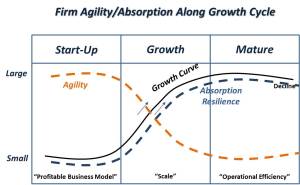Canadian firms spend very little on R&D. Risk adversity is a leading reason for business leader’s preference for investing profits in M&A activities rather than growing the core through R&D, innovation, and new product development. R&D projects or projects with development work almost always suffer from schedule and cost overruns so business leaders avoid the trouble and invest profits in ways that they understand and feel are more predictable. The problem is that no new value is created and is quite often destroyed with M&A. Firms that can effectively manage uncertainty in R&D projects can achieve higher profits, growth, and improved competitiveness.
How can firms better manage uncertainty in R&D, new product development, and innovation? The project constraint triangle is a helpful tool for R&D project managers to develop proactive strategies to manage uncertainty in R&D allowing business leaders to make wise investment decisions with effective risk mitigation and achieve their strategic business goals.
Product Development Project Constraint Triangle
The product development project constraint triangle helps to understand how to manage the impact of uncertainty in R&D projects, new product development, and innovation. The project constraint triangle is illustrated below:
Most project managers understand this constraint triangle very well – project outcomes are constrained by scope, resources, and schedule. Project outcomes are viewed simultaneously both externally, from the market’s perspective, and internally, from the firm’s perspective. The market wants value (performance, quality), at a good price, and when they need it. The firm wants profitable projects (efficient expenses) at acceptable risk leveraging their resources (core competencies in people, process, tools, and intellectual property). Project managers continually trade-off cost and schedule to achieve project outcomes in normal projects with low to moderate risk in the application of normal project &risk management methods with schedule buffers and budget risk contingencies.
In the case of R&D projects, new product development, and innovation uncertainty and the resulting risk is much higher. Development uncertainty occurs in scope with effects impacting schedule (schedule overruns) and resources (cost overruns). Firms with low risk tolerance usually stop here. The project constraint triangle though helps us to clarify management approaches for lowering uncertainty in R&D projects and insight into how firms can better manage uncertainty.
Uncertainty Management Strategies
The project constraint triangle define the trade-off space for project managers and reveals several strategies for managing uncertainty in R&D projects. The strategies are:
- Fix Resources + Fix Scope -> Vary Schedule
- Fix Scope + Fix Schedule -> Vary Resources
- Fix Schedule + Fix Resources -> Vary Scope
- If Able Contractual Relief Valves: Scope Relief, Schedule Relief, Resource Relief.
We often implicitly understand these alternatives but don’t explicitly state them nor proactively exploit them to their full potential for their improved business outcomes through better mitigation. Our business assumptions also can impede how we might exploit them to their full potential. We also need to consider the market context for how we might exploit these strategies in business-to-consumer, business-to-business, and business-to-government markets.
These strategies ultimately decide where the impact of uncertainty is absorbed in mitigation. This is the key to proactively managing the impact of uncertainty rather than just reacting too late.
Strategy #1: Fix Resources + Fix Scope -> Vary Schedule
This is the default strategy for most firms where uncertainty in R&D projects is absorbed when schedule buffers are exceeded by extending the schedule (ie. schedule overrun). The schedule overrun may then cause cost overruns from the continued involvement from the ‘standing army’ assigned to the project who must deliver the fixed scope beyond the budget risk contingency. Inexperienced firms fall into this trap and further reinforcing their risk adversity.
Resources are fixed in R&D projects because R&D staff are often constrained by the finite and limited number of internal staff with unique knowledge, skills, and experience and labour market constraints from engineering or specialist shortages. Cost savings by reducing R&D staff levels further constrains R&D project managers during difficult times.
Scope is fixed by the market requirements process leading to a product specification and customer needs definition. Project planning processes require a precise scope definition to permit solution definition, estimation, and scheduling resources.
Implicit assumptions in this strategy are that R&D teams can’t find additional productive resources when needed to deliver the project and the project scope is sacred. When uncertainty arises we need to wait for our fixed resources to become available and if their work is on the project critical path a schedule delay results. R&D project managers often become the ‘scape goat’ when all available project buffers are gone.
Strategy #2: Fix Scope + Fix Schedule -> Vary Resources
This strategy is based on the assumptions that the scope can’t be changed and the project deliverables must meet a certain date. Uncertainty is absorbed by adding more resources and therefore cost to the project. Market driven firms in highly competitive industries are extremely sensitive to schedule so must fix the schedule so are more likely to adopt this strategy. Firms realize that they can’t go it alone to achieve their strategic goals.
Additional resources can be added by several methods:
- Subcontracting R&D work packages to access productive resources with specialist knowledge.
- Partnering with another firm with applicable core competencies.
- Collaboration with university or R&D institutes to access resources.
The suitability of these approaches is determined by the project profitability (and profit sharing), responsiveness and alignment with other business entities, and understanding the critical path of the R&D project schedule. Internal resistance often impedes outsourcing R&D as does the ‘not designed here’ behaviour driven by the belief that specialist knowledge does not exist in other firms.
Strategy #3: Fix Schedule + Fix Resources -> Vary Scope
This strategy is based on challenging the assumption that scope can’t be changed. The schedule date is fixed and limited R&D resources are fixed so uncertainty is absorbed by backing off of the scope promises tied to where uncertainty is impacting the project critical path.
Scope reduction methods that can absorb the impact of uncertainty are:
- Minimum viable product approaches.
- Spiral product development approaches that offer future upgrades based on solutions to uncertain elements of the product concept.
- Differentiating between must-haves and nice-to-haves.
- Prepare upfront alternative ‘plan Bs’ for uncertain elements of the product.
- Specify functions not solutions to provide technology trade-off spaces for design decisions.
Unfortunately R&D projects often get locked into contracts that drive precise scope definition without building in scope reduction mechanisms. Firms become fixated on certain solutions and become blind to alternatives. Firms also assume that customers won’t want a partial product even though the customers may not even be aware of the product concept.
Strategy #4: Contractual Relief Valves: Scope Relief, Schedule Relief, Resource Relief
In certain markets, such as government defence markets where novel scope is required, contractual relief valves are used. Scope is also often added to defence contracts after contract award as security threats change in response to world events resulting in opportunities for schedule and cost relief. Rarely is scope reduced to meet budget and schedule when uncertainty threatens to use up project buffers.
Contractual relief is also employed in business-to-business markets as customer needs change after contract award. For consumer markets though contractual relief is not applicable requiring R&D project managers to proactively provide trade-off margins to work within the project constraint triangle long before market launch.
In a rapidly changing world relief valves are becoming increasingly important to build into R&D projects upfront in order to achieve business objectives.
Lessons For Proactive Management of Uncertainty in R&D Projects
How can we use the insight provided by the project constraint triangle to manage uncertainty in R&D projects better? Firms should develop a hybrid application of these strategies appropriate for your firm and your market and consider the following:
- Draw out and challenge underlying assumptions influencing uncertainty mitigation methods in R&D projects in your firm. This may point to the need for broader cultural change as these may be deeply rooted in your employee’s underlying beliefs.
- Build mechanisms for scope relief up front in the R&D project plan by recognizing that uncertainty may exceed original plan or the market may have changed since the project was started. Don’t default to strategies that default to absorbing uncertainty by schedule and cost overruns.
- Adopt project risk management methods for novel projects.
- Activities with high uncertainty need to be removed from the critical path of the project either through the solution choice or realistic technology road mapping that can underpin a spiral development path.
- Higher percentage of reuse to achieve the scope. Focus new development areas that limits uncertainty to 10-20% and build in schedule buffers and risk contingency to fit the selected percentage.
- Investment of time and effort to develop productive subcontractors well ahead of the R&D project because firms can’t go it alone in today’s markets. Invest in familiarizing them in your work processes, building personal connections with R&D staff to understand strengths, and improving communications.
- Early development of partners with compatible strategies well ahead of the R&D project.
- Building solution alternatives (plan B and C) to achieve the scope into the R&D project plan.
- Early collaboration with university and R&D institutes off the critical path of the project.
- Schedule buffers and budget risk contingency need to fit the level of uncertainty present in the project.
These approaches speak to the need for a broader and more holistic approach to how R&D, innovation, and new product development support your firm’s business strategy. Failing to develop partnerships and supplier relationships in advance doesn’t position R&D projects for success. Constraining the proportion of development activity to manageable levels while taking a longer term perspective also frees up R&D project managers to make effective trade-offs in the project constraint triangle. Experienced firms tend to understand these trade-offs better and build these strategies into their R&D, new product development, and innovation investments.




